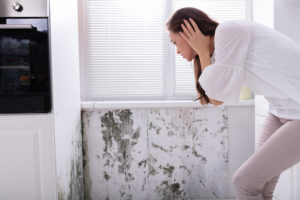THE DANGERS OF MOLD IN YOUR HOME
Do you have mold in your home? In truth, just about everyone does. When it’s allowed to grow and spread, though, it can cause significant health risks and damage to your home.
Mold needs only oxygen and moisture to grow and spread, and it grows by releasing spores into the air. These spores are invisible to the naked eye and can enter your home through windows, vents, and doorways. Spores can also be carried into your home on clothing and pets. One cubic foot of air can contain hundreds or even thousands of mold spores, and when they land on a wet or damp spot, spores begin to grow, producing allergens, irritants, and toxic substances.
Mold can grow just about anywhere, and it’s commonly found on surfaces like insulation, sheetrock, tile, fabrics, and wood. People with mold allergies or pre-existing health conditions can develop serious infections in their lungs from mold exposure, and even healthy people may experience throat irritation, coughing, wheezing, nasal stuffiness, and eye irritation when exposed to high levels of mold. Mold spores can worsen asthmatic symptoms, and some studies even link early mold exposure to childhood asthma.
Toxic black mold is particularly problematic. Feeding on common household materials that have been exposed to moisture, black mold releases spores that can cause a wide range of unpleasant or even dangerous symptoms. Chronic coughing and sneezing, irritation to the eyes, mucous membranes of the nose and throat, persistent headaches, rashes, and chronic fatigue, are the most common effects of black mold exposure or black mold poisoning. Sometimes, the effects of black mold are much more dangerous and can include nausea, vomiting, and bleeding in the lungs and nose.
Mold damages your home, too. It grows around leaks in your home’s roof, windows, and pipes, and in damp places like showers and basements. As it grows, it feeds off its source, so if that source is drywall, wood, or another material found in your home’s structure, it can be severely damaged. Further, in order to get rid of the mold, the materials in which it’s growing will need to be removed from the home.
Getting rid of mold can be difficult and costly, so it’s important to control mold growth in your home. Keep your indoor humidity below 60 percent, ventilate damp rooms, and fix any leaks as soon as possible. Move wet clothes from the washer to the dryer immediately, and use dehumidifiers in areas of the home where mold tends to grow.
If you need help getting rid of mold, call Indoor Green Solutions. We’ve got more than 10 years of experience remediating mold, not just removing mold from houses, but providing preventative measures to keep the mold from coming back. Nationwide Certified Mold Assessors and Remediators, we use EPA certified methods, and guarantee 100 percent satisfaction, providing a warranty for all of our services. Contact us through our website or call 888-707-5285 for your free estimate.

